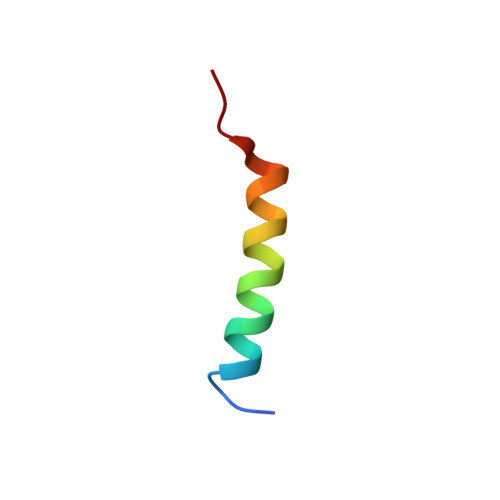NS2 Proteins of GB Virus B and Hepatitis C Virus Share Common Protease Activities and Membrane Topologies.
Boukadida, C., Marnata, C., Montserret, R., Cohen, L., Blumen, B., Gouttenoire, J., Moradpour, D., Penin, F., Martin, A.(2014) J Virol 88: 7426-7444
- PubMed: 24741107
- DOI: https://doi.org/10.1128/JVI.00656-14
- Primary Citation of Related Structures:
2LZP, 2LZQ, 2MKB - PubMed Abstract:
GB virus B (GBV-B), which is hepatotropic in experimentally infected small New World primates, is a member of the Hepacivirus genus but phylogenetically relatively distant from hepatitis C virus (HCV). To gain insights into the role and specificity of hepaciviral nonstructural protein 2 (NS2), which is required for HCV polyprotein processing and particle morphogenesis, we investigated whether NS2 structural and functional features are conserved between HCV and GBV-B. We found that GBV-B NS2, like HCV NS2, has cysteine protease activity responsible for cleavage at the NS2/NS3 junction, and we experimentally confirmed the location of this junction within the viral polyprotein. A model for GBV-B NS2 membrane topology was experimentally established by determining the membrane association properties of NS2 segments fused to green fluorescent protein (GFP) and their nuclear magnetic resonance structures using synthetic peptides as well as by applying an N-glycosylation scanning approach. Similar glycosylation studies confirmed the HCV NS2 organization. Together, our data show that despite limited amino acid sequence similarity, GBV-B and HCV NS2 proteins share a membrane topology with 3 N-terminal transmembrane segments, which is also predicted to apply to other recently discovered hepaciviruses. Based on these data and using trans-complementation systems, we found that intragenotypic hybrid NS2 proteins with heterologous N-terminal membrane segments were able to efficiently trans-complement an assembly-deficient HCV mutant with a point mutation in the NS2 C-terminal domain, while GBV-B/HCV or intergenotypic NS2 chimeras were not. These studies indicate that virus- and genotype-specific intramolecular interactions between N- and C-terminal domains of NS2 are critically involved in HCV morphogenesis. Nonstructural protein 2 (NS2) of hepatitis C virus (HCV) is a multifunctional protein critically involved in polyprotein processing and virion morphogenesis. To gain insights into NS2 mechanisms of action, we investigated whether NS2 structural and functional features are conserved between HCV and GB virus B (GBV-B), a phylogenetically relatively distant primate hepacivirus. We showed that GBV-B NS2, like HCV NS2, carries cysteine protease activity. We experimentally established a model for GBV-B NS2 membrane topology and demonstrated that despite limited sequence similarity, GBV-B and HCV NS2 share an organization with three N-terminal transmembrane segments. We found that the role of HCV NS2 in particle assembly is genotype specific and relies on critical interactions between its N- and C-terminal domains. This first comparative analysis of NS2 proteins from two hepaciviruses and our structural predictions of NS2 from other newly identified mammal hepaciviruses highlight conserved key features of the hepaciviral life cycle.
Organizational Affiliation:
Institut Pasteur, Unit of Molecular Genetics of RNA Viruses, Paris, France CNRS UMR3569, Paris, France Université Paris Diderot-Sorbonne Paris Cité, Paris, France.














